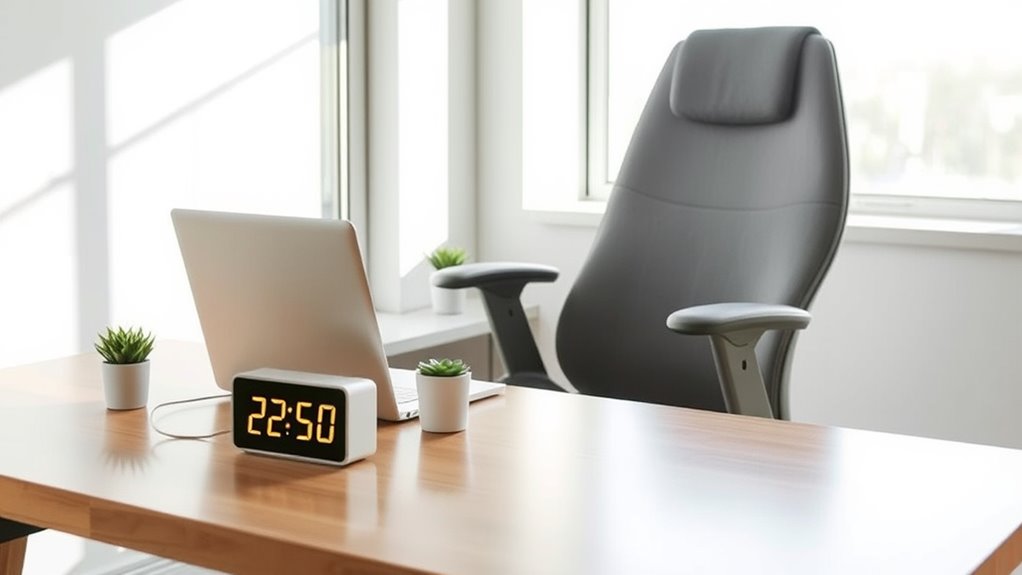To get a quick cognitive boost, aim for a power nap lasting 10 to 20 minutes. This duration keeps you in lighter sleep stages, helping you wake up refreshed without feeling groggy. Waking from deeper stages like REM or deep sleep can cause sleep inertia, leaving you groggy and less alert. Understanding your sleep cycles better can help you optimize your nap for maximum clarity and energy, so keep exploring how timing and length make a difference.
Key Takeaways
- Power naps of 10-20 minutes primarily involve lighter sleep stages, providing quick refreshment and increased alertness.
- Naps over 30 minutes risk entering deep sleep, which can cause grogginess upon waking and reduce cognitive benefits.
- Short naps help avoid sleep inertia, making them ideal for immediate cognitive boosts and improved focus.
- Aligning nap duration with sleep cycles maximizes benefits, with 10-20 minutes targeting lighter sleep stages for quick recovery.
- Longer naps (around 90 minutes) allow full sleep cycles, supporting memory, emotional regulation, and deeper cognitive restoration.

Power naps have gained popularity as a quick way to boost energy and improve focus, but their benefits are backed by scientific research. Understanding how sleep cycles and nap durations influence these benefits is key to maximizing their effectiveness. Sleep cycles, which typically last about 90 minutes, consist of various stages that your brain moves through during sleep, including light sleep, deep sleep, and REM sleep. When you take a nap, you’re essentially tapping into these cycles, and the length of your nap determines which stages you reach and whether you wake up feeling refreshed or groggy.
Power naps tap into 90-minute sleep cycles, shaping how refreshed or groggy you feel afterward.
If you nap for too long, especially beyond 30 minutes, you risk entering deeper stages of sleep like slow-wave sleep. Waking up from these stages can leave you feeling groggy and disoriented—a phenomenon known as sleep inertia. That’s why longer naps, such as 60 to 90 minutes, often lead to this sluggish feeling, even though they allow your brain to complete full sleep cycles. On the other hand, shorter naps of about 10 to 20 minutes are typically called power naps for a reason. They mainly involve lighter sleep stages, like Stage 1 or Stage 2, which help you feel more alert and focused without experiencing sleep inertia.
The ideal nap duration depends on what you’re aiming for. If you need a quick boost without the risk of grogginess, sticking to about 10 to 20 minutes is your best bet. This length keeps you in the lighter sleep stages, allowing you to wake up energized and ready to tackle tasks. Conversely, if you’re looking for more restorative benefits, a 90-minute nap might be worthwhile because it allows your brain to complete a full sleep cycle, including REM sleep, which is important for memory and emotional regulation. However, longer naps may not always be practical during a busy day, which is why many people prefer shorter, more focused power naps.
It’s also worth noting that individual differences, such as age and sleep habits, can influence how long you should nap. But in general, understanding sleep cycles and tailoring your nap duration accordingly can considerably boost your cognitive performance. Keep your naps brief if you want quick refreshment, and consider longer sessions if you have the time and need deeper recovery. By aligning your nap length with your sleep cycle, you make the most of these short breaks and enjoy the cognitive benefits they offer. Additionally, circadian rhythms play a role in determining the optimal timing of naps, helping you avoid disruptions to your overall sleep pattern.
Frequently Asked Questions
Do Power Naps Affect Nighttime Sleep Quality?
Power naps can affect your nighttime sleep quality, especially if they disrupt your circadian rhythm. If your nap is too long, you might experience sleep inertia, making it harder to wake up feeling refreshed. Short naps, around 10-20 minutes, usually don’t interfere with your nighttime sleep and help boost alertness. Pay attention to how your body responds, and try to nap earlier in the day to avoid disrupting your sleep cycle.
Can Power Naps Improve Long-Term Memory Retention?
Think of your brain as a garden where memory retention blooms. Power naps act like gentle watering, boosting memory consolidation and supporting brain plasticity. Short naps, around 20 minutes, help reinforce what you’ve learned, making long-term memory retention easier. Regular naps encourage your brain to adapt and grow stronger, helping you retain information better over time. So, a quick nap can be a powerful tool for enhancing your memory’s resilience.
Are Power Naps Effective for All Age Groups?
You might wonder if power naps work for everyone. The truth is, age-related benefits vary; younger people often recover quickly and boost alertness, while older adults may experience more significant cognitive gains. Cultural differences also influence effectiveness—some cultures value midday naps, making them more accepted and beneficial. So, yes, power naps can be effective across age groups, but their impact depends on individual needs and cultural attitudes.
What Are the Best Times of Day for Power Naps?
You might think any time works for a power nap, but ironically, your circadian rhythms reveal otherwise. The best times are early afternoon, around 1-3 pm, when your alertness dips naturally. During these windows, ideal nap durations can boost cognition without disrupting nighttime sleep. So, don’t wait until evening when your body’s already winding down—your brain’s craving a quick recharge at the right moment.
Do Power Naps Have Any Negative Health Effects?
You might wonder if power naps have negative health effects. Generally, short naps can help reduce sleep deprivation and boost alertness, but longer or poorly timed naps could cause sleep inertia, leaving you groggy. In some cases, excessive napping may interfere with nighttime sleep, leading to health issues. Keep naps brief—around 10-20 minutes—to avoid these negatives and enjoy the benefits without disrupting your overall sleep cycle.
Conclusion
Now that you know the ideal length for a power nap, it’s clear that sometimes less is more. A quick rest can boost your focus, yet overdoing it might leave you groggy and unproductive. Just like a brief pause can sharpen your mind, too long a break can dull your edge. So, embrace the perfect nap duration—short enough to invigorate, long enough to refresh—reminding you that balance is the key to true power.











